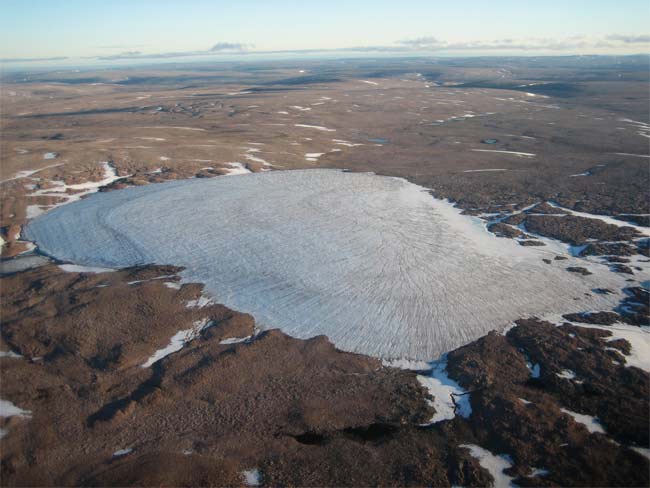Arctic Ice Fields 'Receding Like Mad'

Ice fields on an Arctic island have shrunk 50 percent in the past 50 years and will be gone in 50 more, scientists said this week.
Located just west of Greenland, Baffin Island is the fifth largest island in the world, with an area of 196,000 square miles (about 508,000 square kilometers). That's larger than California.
A study published in the Jan. 28 issue of the journal Geophysical Research Letters reveals the expanses of ice blanketing Baffin's northern plateau in the Canadian Arctic are smaller than at any time in at least the last 1,600 years.
"Even with no additional warming, our study indicates these ice caps will be gone in 50 years or less," said study researcher Gifford Miller of the University of Colorado, Boulder's Institute of Arctic and Alpine Research.
Temperatures across the Arctic have been rising substantially in recent decades as a result of the buildup of greenhouse gases in Earth's atmosphere, say the researchers. It's this warming trend they say is behind Baffin's meltdown.
Ice domes
Baffin's ice caps, which are domes of ice too small to be labeled ice sheets as those on Greenland are, span just four miles (about six kilometers) long.
Get the world’s most fascinating discoveries delivered straight to your inbox.
What makes the ice fields such great study sites is the fact that they are very thin, generally less than 300 feet (91 meters) thick, and they're very cold, so they don't flow and erode the landscape beneath as most glaciers do.
"It's so cold that there's no water at their bed, and they're basically completely frozen to the bed," Miller said. "They preserve beneath them the landscape exactly intact upon which the first snow fell that eventually became the ice cap." Miller and his colleagues analyzed radioactive carbon in dead plant material emerging from beneath the receding ice margins, which would tell them the last time these plants had been exposed to the atmosphere.
The oldest dates are from about 1,600 years ago, suggesting the ice fields have remained intact for that long, that is, until 2005 when the scientists sampled the now-exposed plant material.
In addition, they extrapolated other radiocarbon data along with satellite imagery to calculate the historical ice-cover and ice-free area in the same area. Toward the end of Little Ice Age, in the mid-1800s, permanent snow and ice covered 1,351 square miles (3,500 square kilometers) in this area. In 2002, coverage was just 41 square miles (107 square kilometers).
Warmer than normal
While researchers have known that the Earth is much warmer than 150 years ago, when the Northern Hemisphere was stuck in the Little Ice Age, they are less certain about how today's temperatures compare with a warmer period in our planet's past. For instance, Miller notes there has been a debate over whether today's climate is warmer than it was during the Medieval times, about 1,000 years ago.
Some of the ice fields studied formed in pre-Medieval times, Miller said, and persisted until now.
"That tells us right there that the warming of the 20th century is the warmest sustained period of warming in that time," Miller said. "It clearly says we're now warmer than we were in Medieval times."
Hidden behind this short-term warming and ice-cap melting, Miller explained, is a long-term period of relative cooling.
"The general trend has been cooling for the past 10,000 years," Miller told LiveScience. "The fact that they are now receding like mad just makes it even more unusual because the large-scale forcing, how much energy comes in from the sun during the summer months, is getting less and less."
- 10 Surprising Results of Global Warming
- Global Warming: How Do Scientists Know They're Not Wrong?
- Image Gallery: Glaciers Before and After
Jeanna Bryner is managing editor of Scientific American. Previously she was editor in chief of Live Science and, prior to that, an editor at Scholastic's Science World magazine. Bryner has an English degree from Salisbury University, a master's degree in biogeochemistry and environmental sciences from the University of Maryland and a graduate science journalism degree from New York University. She has worked as a biologist in Florida, where she monitored wetlands and did field surveys for endangered species, including the gorgeous Florida Scrub Jay. She also received an ocean sciences journalism fellowship from the Woods Hole Oceanographic Institution. She is a firm believer that science is for everyone and that just about everything can be viewed through the lens of science.


